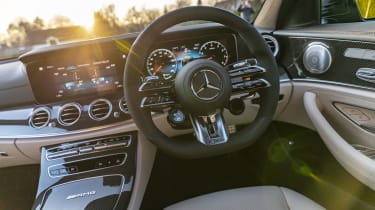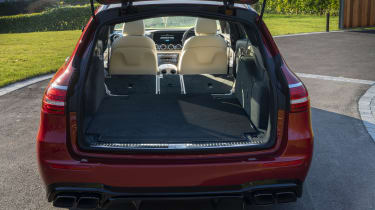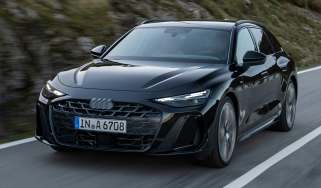Mercedes-AMG E 63 Estate review (2016-2023)
"The Mercedes-AMG E63 Estate has all the appeal of the fearsome saloon model, with added practicality"
Pros
- Incredible performance
- Top-notch quality
- Huge boot
Cons
- Expensive to run
- 'S' model hard to justify
- Some safety features optional
The Mercedes-AMG E 63 Estate made a big impression when the first version arrived around a decade ago and the intervening years have seen a lot of changes to Mercedes' family-friendly dragster.
This latest version still faces competition from the Audi RS6 Avant estate but to make sure it fights on even terms, the E 63 is only available in the feistiest ‘S’ form for UK buyers. Its standard 4MATIC four-wheel drive system matches the Audi's quattro system in its promise of improved traction in wet weather and on poor roads.
While some may miss the tail-happy rear-wheel-drive antics of the previous model, the latest car is far easier to drive enthusiastically and there's no doubt it sends its power to the ground effectively. The standard E 63 had 563bhp but most UK buyers went straight for the 604bhp E 63 S, which is capable of dispatching the 0-62mph sprint in just 3.5 seconds, making this one estate that really is on nodding terms with supercars.
The E 63 is more than just a fast, great-looking estate car, though – it also impresses in the way it cossets passengers when the pedal isn't to the metal. Like any other Mercedes E-Class, it has a hi-tech interior with a glossy, expensive look, and occupants are treated to great comfort while being surrounded by high-class materials. There's stacks of luxury equipment fitted as standard and a bespoke front bumper, unique wheels and AMG body styling kit ensure your E 63 will never be mistaken for a lesser E-Class Estate.
More reviews
While the latest 4.0-litre V8 twin-turbo engine uses less petrol than the previous engine, the E 63 is still some way from being truly economical. Drive carefully and you’ll achieve 22.8mpg but it’ll be significantly less if you make the most of the E 63’s impressive performance. Other running costs will be substantial, too – you'll receive a near-£500 yearly road-tax bill, servicing will be quite costly and consumable parts such as tyres and brakes can be very expensive indeed.
In all other respects, the E 63 offers the same package as any other Mercedes E-Class Estate. That means one of the biggest boots in the business, loads of space inside and a generous roster of safety equipment, with more available optionally. The E-Class boasts a five-star Euro NCAP safety rating, and, although it didn't feature in our 2020 Driver Power owner satisfaction survey, the brand has a reasonable reputation for reliability.
Owners of previous E 63 Estates won't be disappointed by the new model, and anybody in the market for a spacious family estate car that can embarrass a Porsche 911 with its straight-line speed would be wise to check one out.
MPG, running costs & CO2
The decision to buy a car like a Mercedes-AMG E 63 Estate isn't to be taken lightly, although its £100,000 price tag means only the lucky few will be able to seriously consider one. While it resembles other models in the range, monthly running costs are deep into sports-car territory and you could feel it pinching your pocket with every mile you travel.
There's some good news in that its 4.0-litre twin-turbocharged engine is more efficient than before but some will still find 22.8mpg fuel consumption a tough pill to swallow – and it's likely to drop rather a lot if you regularly make full use of all that power. The electric Porsche Taycan Cross Turismo offers far lower running costs but it’s not as practical and is more expensive to buy.
Doing that might also quickly introduce you to the next expensive part of AMG ownership: the replacement of wear and tear components. Things like tyres – and particularly brakes – can be very costly, and this is not a car where you can skimp on regular maintenance. Mercedes does offer service plans to help spread the cost and there's a three-year/unlimited-mileage warranty. The Mercedes-AMG E 63 estate occupies the highest insurance group in the UK, too.
With huge CO2 emissions of 282g/km, the E 63 is not a machine that company-car users will relish paying tax on – it occupies the highest 37% Benefit-in-Kind (BiK) band. Private buyers will face expensive annual tax bills, too – as with all cars over £40,000, owners face a bill of nearly £500 the first five times annual road tax is paid, falling to the standard rate from year six.
Engines, drive & performance
The E 63 shares its Mercedes-AMG badge with the mild-hybrid E 53 but its V8 engine unlocks a whole new level of performance that the less expensive model can't hold a candle to. This has always been the case with Mercedes' most powerful estate car – it really can be seen as a supercar with split-folding rear seats.
Key to this is a 4.0-litre twin-turbocharged V8 engine. It's smaller than those in previous E 63s but you wouldn't know it to look at the list of vital statistics – 604bhp is on tap, allowing a 0-62mph time of just 3.5 seconds and a top speed of 180mph.
Both versions start with the same portentous rumble, which settles into a soft burble until you put your foot down. Then, the AMG performance exhaust comes into play, and the sound becomes ever more thunderous as the rev counter and speedometer needles race each other. Mercedes has even engineered the engine computer to produce evocative bangs and pops when you lift off the throttle.
This is a two-tonne estate car that encourages mischief behind the wheel, but whose handling is ultimately benign and easy to drive quickly while remaining safe. The steering response is immediate when you first turn into a corner and the E 63 feels a lot more willing to work with you than an Audi RS6 Avant – while the Audi coolly responds to your inputs, the Mercedes goads you on with encouragement.
There's loads of scope to tailor the E 63's responses, too. The driving modes (comfort, sport, sport+ and race) tweak the suspension, steering, gearbox and accelerator response to suit your mood and have enough variation between them to be worthwhile. What's more, despite huge alloy wheels with low-profile tyres, comfort mode is indeed comfortable when all you want to do is get home swiftly and without stress.
And, although the exhausts fire off menacing salvos when you're driving fast, the noise backs off at cruising speeds, where the E 63 takes on a more relaxed persona.
Interior & comfort
We're big fans of the E-Class interior – it exudes much of the class and sophistication of the flagship Mercedes S-Class, combining classic, elegant lines and cutting-edge technology, and special AMG touches lend the E 63 a sporty ambience. There's a veritable stack of standard equipment, too.
All E 63s boast Mercedes' excellent widescreen display, which creates the impression of a single full-width screen that runs halfway across the dashboard. The portion ahead of the driver incorporates a digital instrument panel that offers AMG-specific data such as engine and gearbox temperature as well as a lap timer. The second swathe of full-colour screen plays host to the MBUX infotainment display, with 3D mapping and online functionality.
The front seats are heated and power-adjustable with a memory function, while they and the steering wheel are richly upholstered in soft Nappa leather with AMG emblems. The upper section of the dashboard is trimmed to match with Nappa leather on the E 63 S model. Similarly high-quality materials are found elsewhere inside – any plastic surfaces your fingertips encounter are either soft to the touch or made from heavy, resilient materials that feel built to last.
Other standard equipment includes power-folding mirrors, LED headlamps, rain-sensing wipers, a reversing camera, dual-zone climate control, 64-colour ambient lighting with a 'welcome' feature, DAB radio and two USB ports that support Android Auto and Apple CarPlay.
At cruising speed it's also quiet enough inside the E 63 to allow all this entertainment to be enjoyed – and although there's a bit of a roar from those huge tyres, comfort mode does a good job of smoothing out most road imperfections.
Practicality & boot space
E 63 Estate buyers really can argue that their choice is justified by its practicality. The fastest E-Class loses almost nothing in terms of day-to-day usefulness compared to lesser models – it has the same 640-litre boot, which can be expanded to 1,820 litres when the rear seats aren't in use.
No estate car is more adept at carrying luggage than the E-Class, and a hands-free remote control boot lid adds to its convenience when the premium pack is chosen. Unlike other versions, though, the E63 can't be specified with a tow bar – Mercedes doesn't list the model as suitable for towing.
It's just as good at accommodating passengers as other versions, though. The luxurious leather-lined interior offers loads of space for the driver to remain comfortable even after long spells behind the wheel, while those in the back can relax with plenty of legroom. It's a relatively wide car, so front and rear-seat occupants enjoy generous shoulder room, while a higher roofline than the saloon means that headroom is plentiful, too.
There's loads of interior storage, too. Two 750ml drink containers can be held by the centre-console cupholders, with a generous centre compartment adjacent. The large glove box is air-conditioned to keep drinks and snacks cool, while rear-seat passengers have door bins and front seatback nets for oddments and magazines.
Reliability & safety
Too few owners of the Mercedes E-Class, from which the E 63 was developed, participated in our 2020 Driver Power owner satisfaction survey for it to be featured, but the Mercedes brand as a whole finished in a lacklustre 28th position out of 30 carmakers covered.
Interior design and performance was praised but reliability and build quality could be better; 16.5% of buyers reported at least one fault during the first year of ownership.
A car as specific in appeal as the E 63 might inspire different customer views, though – while few will have any complaints on the engine, performance and handling fronts, owners will either condemn or praise its economy depending on whether it's evaluated from the perspective of family workhorse or five-door supercar – it's a car that fulfils both roles.
Safety is not a factor that gives rise to any concerns, though. The E 63 boasts the same five-star Euro NCAP crash safety score as other models, with an enviable 95% score for adult occupancy protection and a similarly impressive 90% rating for child occupancy protection. Autonomous emergency braking is standard.
You can add a 'driving assistance plus package' with further autonomous features, such as active steering assistance, which will gently apply steering if the car senses you're drifting out of your lane. Active speed-limit assistance works with traffic-sign recognition to comply with prevailing speed limits when active cruise control is engaged, while evasive steering assistance will support you if it detects that you're reacting to avoid an obstacle ahead.





















